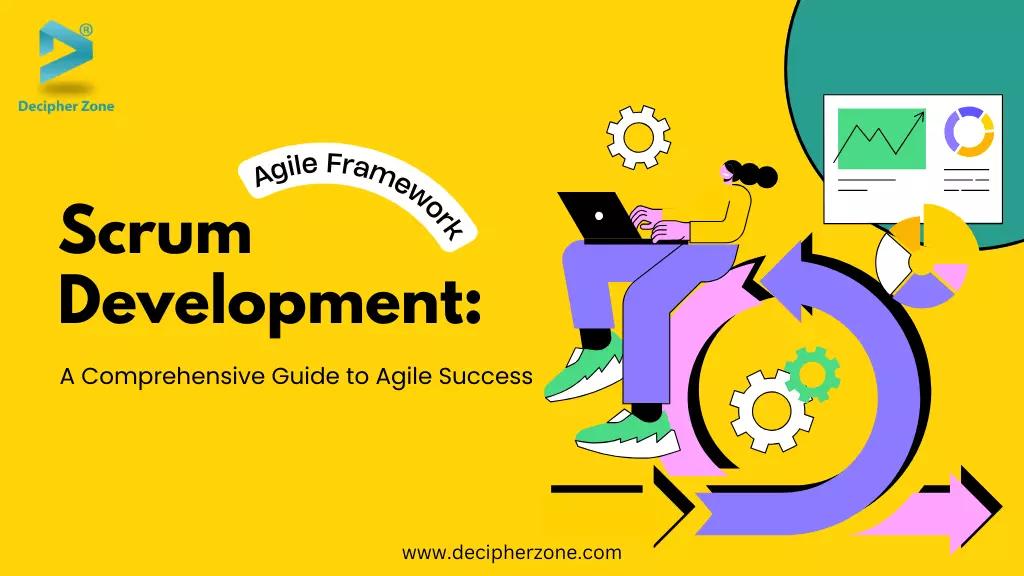Quick Summary:
Scrum is an Agile framework that breaks complex projects into short, iterative cycles (sprints), enabling teams to deliver value faster and adapt to change. In Scrum development, a cross-functional team (product owner, scrum master, developers) works from a prioritized product backlog through a repeatable lifecycle of planning, daily stand-ups, development, review, and retrospective.
This article covers how Scrum works, its benefits, challenges, real-world case studies of Scrum success, and tips to help your Scrum team thrive. Whether you’re a developer, project manager, or business stakeholder, you’ll learn how Scrum can improve project outcomes and what it takes to implement it successfully.
What is Scrum Development in Agile?
Scrum is a lightweight Agile development framework focused on iterative progress, team collaboration, and continuous improvement. In Agile terms, Scrum provides a structured way to apply the Agile philosophy (which values adaptability and customer feedback) into practice.
Agile is the broad mindset of iterative, value-driven development, while Scrum is a specific methodology (framework) within Agile that defines how teams should organize work in short cycles and continuously refine their approach. Think of Agile as the guiding principles and Scrum as one popular way to execute those principles.
Scrum was co-created by Jeff Sutherland and Ken Schwaber in the 1990s as a response to traditional waterfall project failures. It gets its name from rugby – much like a rugby scrum brings players together to strategize, Scrum in development brings team members together to tackle problems. A Scrum team self-organizes and rapidly iterates on product versions, learning and adjusting as they go.
This empirical approach (learning by doing and reflecting) is at Scrum’s core. The Scrum Guide (by Schwaber and Sutherland) formalizes the framework: it defines specific roles, events, and artifacts that Scrum teams use to manage work.
The framework itself is simple and intentionally semi-prescriptive – it provides just enough structure (roles, rules, and events) to remove ambiguity in the development process, while leaving flexibility for teams to adapt.
How Scrum Fits into Agile
Many organizations choose Scrum because it embodies Agile values like frequent delivery, customer collaboration, and responding to change. In fact, Scrum is the most popular Agile methodology worldwide – studies show about 66% of agile teams follow Scrum or a Scrum hybrid, and 81% of all agile teams use some variant of Scrum.
This popularity stems from Scrum’s proven ability to help teams deliver working product increments frequently (typically every 1–4 weeks) and adapt based on feedback.
By breaking down complex projects into manageable sprints, Scrum teams reduce risk and can course-correct quickly. Organizations often start “going Agile” by implementing Scrum because it offers a clear, teachable process to realize Agile’s philosophy of continuous improvement.
Read: Benefits of Agile Software Development
Scrum Development Process (Step-by-Step)
At a high level, here’s how the Scrum process works step-by-step:
-
Product Backlog Creation
-
Sprint Planning & Backlog Selection
-
Sprint Execution & Daily Scrum
-
Sprint Review (Demo)
-
Sprint Retrospective
The iterative Scrum development process – from a stack of requirements (product backlog) to sprint cycles (center) producing potentially shippable product increments (right). Each Scrum cycle (called a sprint) follows a well-defined workflow that makes up the Scrum development lifecycle.
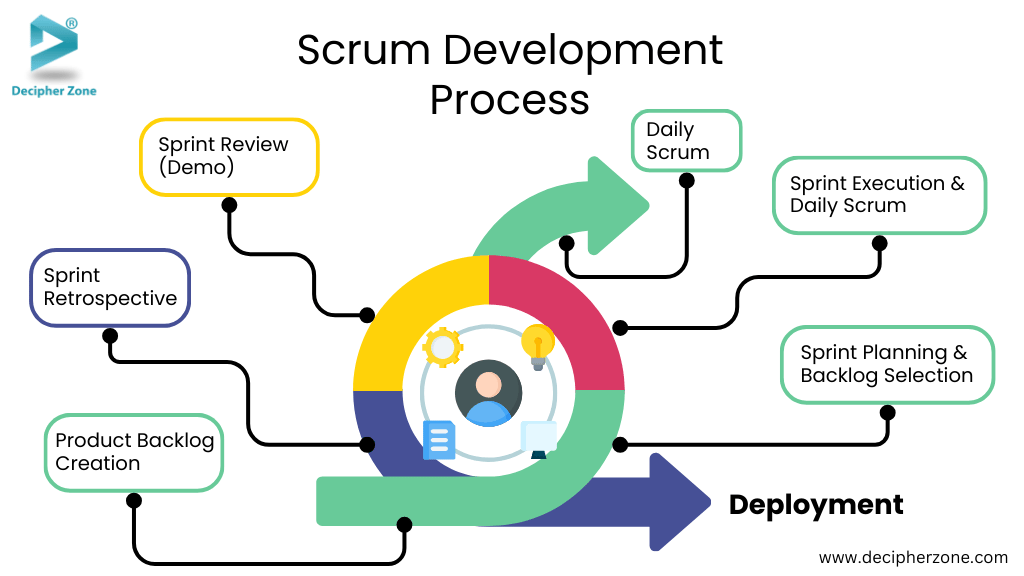
Step 1: Product Backlog Creation
The product backlog is an ordered to-do list of all desired features, enhancements, and fixes for the product. The Product Owner creates and prioritizes this backlog based on business value and stakeholder input. (Think of it as the team’s ultimate prioritized wishlist of work to do.)
Step 2: Sprint Planning & Backlog Selection
At the start of a sprint (a time-boxed iteration, typically 2 weeks), the team holds a Sprint Planning meeting. The Product Owner presents the top priorities from the product backlog, and the team discusses and selects which items they commit to delivering in this sprint (this selection becomes the sprint backlog). The team also defines a clear Sprint Goal – what they intend to achieve in the sprint.
Step 3: Sprint Execution & Daily Scrum
During the sprint, the development team works on implementing the sprint backlog items. Every day, the team meets for a short Daily Scrum (stand-up) – a 15-minute meeting to sync up on progress, plan the day, and surface any blockers. This daily cadence keeps everyone aligned and issues are identified early. Team members typically answer: “What did I do yesterday? What will I do today? Any impediments?”.
Step 4: Sprint Review (Demo)
At the end of the sprint, the team delivers a potentially shippable product increment – a working slice of the product. In the Sprint Review, they demonstrate the completed work to the Product Owner and stakeholders for feedback. The product backlog is then updated (adding new insights or re-prioritizing remaining items) based on this feedback.
Step 5: Sprint Retrospective
After the review, the team holds a Retrospective – an internal meeting to reflect on the sprint. They discuss what went well, what didn’t, and identify improvements for the next sprint. This continuous improvement cycle is crucial; as Agile expert Woody Zuill says: “If you adopt only one agile practice, let it be retrospectives. Everything else will follow.” By iterating on their own process, the team gets better over time.
After the retrospective, the cycle repeats with the next sprint planning. This iterative loop allows for frequent inspection and adaptation of both the product and the process. Importantly, Scrum teams produce some working product increment each sprint, keeping stakeholders involved and ensuring tangible progress.
This short feedback loop drastically reduces the risk of spending months on a product only to discover misalignment – instead, every few weeks there is a checkpoint to adjust course. No wonder Agile projects (with Scrum being a common choice) significantly outperform traditional projects – one study showed Agile projects have about a 42% success rate vs. 13% for Waterfall, and a much lower failure rate.
Scrum Team Roles and Responsibilities
A Scrum team is cross-functional and typically consists of 3 key roles: the Product Owner, the Scrum Master, and the Development Team. Each role has distinct responsibilities:
-
Product Owner (PO)
-
Scrum Master (SM)
-
Development Team Members
A Scrum team conducting a daily stand-up meeting – one of the core Scrum ceremonies. Frequent communication and clear roles are key to Scrum’s success. In Scrum development, roles are clearly defined to ensure accountability and smooth collaboration.

1. Product Owner (PO)
The Product Owner represents the voice of the customer and business. They are responsible for maximizing the value of the product by managing the product backlog. This includes defining user stories (requirements), prioritizing backlog items by business value, and ensuring the team is building the right things in the right order.
The PO works closely with stakeholders and the team to clarify requirements and to accept the work done at the end of each sprint. Essentially, the Product Owner decides what the team should work on next to best meet user needs and business goals.
Build your ideal Scrum team with skilled, experienced professionals. Focus on your product vision—we'll handle the Agile delivery.
Hire Your Dedicated Scrum Team Now →
2. Scrum Master (SM)
The Scrum Master is the team’s coach and process facilitator. They ensure everyone understands and follows Scrum practices and Agile principles. A Scrum Master does whatever it takes to help the team be productive – this can mean removing impediments, shielding the team from external disruptions, and fostering an environment for high performance.
They also facilitate the Scrum ceremonies (planning, daily scrums, reviews, retrospectives). Importantly, the Scrum Master is not a traditional project manager; they serve the team by enabling collaboration and continuous improvement, rather than directing the work.
3. Development Team Members
Often just called “the Developers” (though in Scrum Guide terms it means anyone working to create the product increment – not only programmers). The development team is cross-functional, including all skills needed to deliver the work (e.g. developers, testers, designers, UX, ops engineers, etc.). They self-organize to figure out how to accomplish the Product Owner’s requirements.
Accelerate your Scrum adoption with Decipher Zone’s expert Agile coaching and dedicated development teams.
Schedule Your Free Agile Consultation Today →
The team collectively owns the sprint commitments – they collaborate to design, build, and test the product increment. Scrum teams are typically small (around 5-7 members on average) to stay nimble. Development team members are accountable for delivering high-quality increments and for transparently reporting progress during daily scrums and reviews.
Read: Agile Testing Principles and Methods
Tools and Technologies for Scrum Development
Here are some popular tools and technologies used by Scrum teams:
-
Jira
-
Trello
-
Azure DevOps (Boards)
-
Asana and Monday.com
-
Others (VersionOne, Rally, ClickUp, Notion, GitHub Projects, Slack integrations)
One great advantage of Scrum in today’s world is the abundance of tools that support Agile project management. While Scrum can be managed with sticky notes or spreadsheets, most teams use dedicated software tools to track their backlogs, sprints, and collaboration.
1. Jira
Atlassian’s Jira is one of the most widely used Agile project management tools, practically the de facto choice for many Scrum teams. Jira provides Scrum board templates to manage your product backlog and sprint backlog visually, allowing teams to move user stories through columns (To Do, In Progress, Done).
It supports sprint planning, burndown charts, and countless integrations (CI/CD, source control, etc.). Jira’s robust features make it ideal for software development Scrum teams who need detailed tracking and reporting.
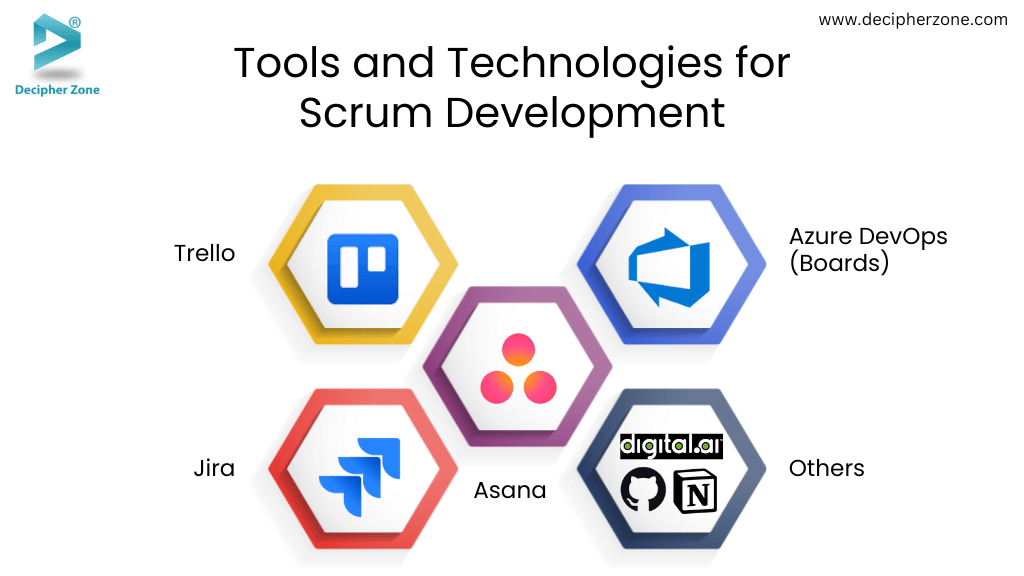
2. Trello
Also from Atlassian, Trello is a simpler kanban-style board tool that many Scrum and Kanban teams use. Trello boards and cards can represent the Scrum backlog and tasks, and its drag-and-drop interface is user-friendly. It’s great for smaller teams or less technical stakeholders, and can be adapted for basic Scrum processes (though it lacks built-in sprint management like Jira).
3. Azure DevOps (Boards)
Microsoft’s Azure DevOps includes Boards for Agile planning. It allows creating backlogs, sprints, and tracking work items. Azure Boards integrates well with the development pipeline (repos, builds, deployments), making it a strong choice for .NET/ Windows-centric Scrum teams or any team already using Azure services.
4. Asana and Monday.com
These are project management platforms that offer Agile templates. Asana, for example, can be configured with custom boards or timeline views for Scrum sprints. Monday.com similarly offers visual boards. They are often used in marketing or business teams practicing Scrum or Kanban, due to their intuitive UI and flexibility.
5. Others:
There are many other Agile tools – e.g. VersionOne (Digital.ai), Rally (Broadcom), ClickUp, Notion, GitHub Projects, etc. – each with its own strengths. Some teams even use Slack or MS Teams combined with apps/bots (like daily stand-up bots or integrated backlog tools) to facilitate Scrum ceremonies and communications.
The key is that a good Scrum tool should let the team easily manage their backlog, plan sprints, visualize work in progress, and measure outcomes (like burndown charts or velocity). This way, the tool supports the framework: keeping everyone on the same page and freeing the team to focus on actual work instead of administrivia.
Top 5 Benefits and Drawbacks of Scrum Methodology
Like any methodology, Scrum has its advantages and disadvantages. Understanding both is key to setting realistic expectations and applying Scrum effectively.
5 Benefits of Scrum:
-
Faster Delivery & Adaptability
-
Higher Product Quality
-
Transparency and Stakeholder Engagement
-
Improved Team Morale & Collaboration
-
Predictability & Risk Management
1. Faster Delivery & Adaptability
Scrum’s iterative sprints ensure that teams deliver working product features frequently (often every 2-4 weeks). This means value gets to users faster and the project can adapt quickly if requirements change. Regular feedback each sprint helps catch misalignments early.
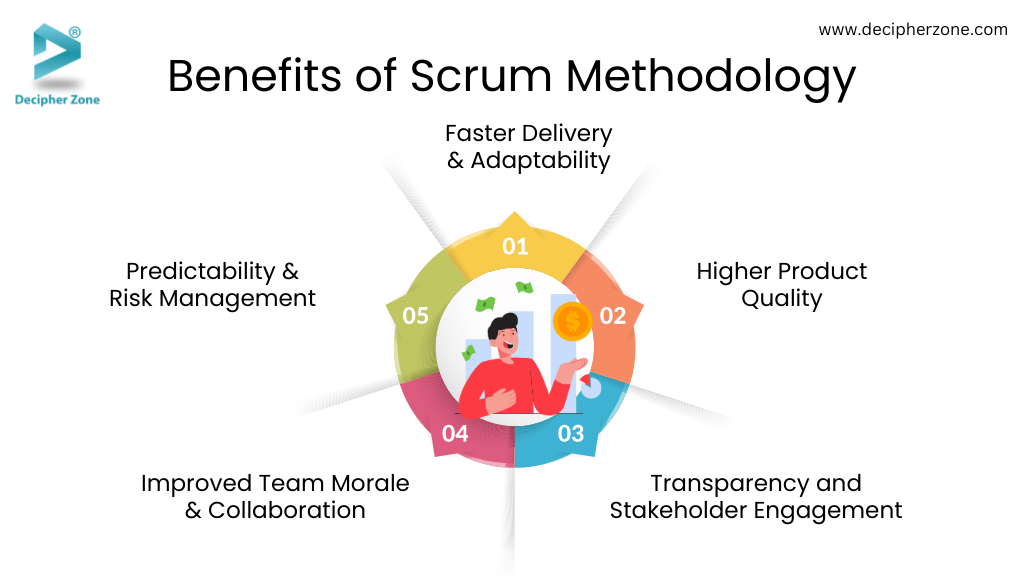
2. Higher Product Quality
Scrum emphasizes the definition of done, testing within each sprint, and continuous improvement. By estimating and right-sizing work, Scrum teams often reduce defect rates significantly.
One analysis found teams using Scrum’s estimation and iterative approach had 50% fewer defects on average than teams that didn’t, leading to 250% higher work quality. Frequent reviews also ensure the product continually meets user expectations.
3. Transparency and Stakeholder Engagement
All Scrum ceremonies (stand-ups, reviews, retrospectives) promote transparency. The whole team and stakeholders have visibility into progress and blockers. The sprint review in particular invites stakeholders to see the increment and give input, fostering customer collaboration. This frequent communication builds trust – everyone can see tangible progress and contribute ideas throughout the project, not just at the end.
4. Improved Team Morale & Collaboration
Scrum teams self-organize and are empowered to make decisions on how to do the work. This autonomy and clear short-term goals often lead to higher team morale and ownership. In fact, 85% of teams reported improved work life after adopting Scrum. Daily scrums and cross-functional teamwork break down silos; developers, testers, designers, etc. work together closely, which boosts camaraderie and knowledge sharing.
5. Predictability & Risk Management
Time-boxed sprints enforce discipline – scope is fixed per sprint, which can improve the predictability of delivery. Stakeholders know they’ll get an increment by a set date. Meanwhile, the risk of big failures is mitigated by delivering in small chunks.
Problems are surfaced early rather than at the very end. This incremental delivery also means that if a project needs to be cancelled or changed, you still have some usable product, rather than sunk costs.
Read: Project Management Methodologies
5 Disadvantages of Scrum:
-
Requires Cultural Change and Discipline
-
Scope Creep or Uncertain End-date
-
Intense for Teams
-
Needs Experienced Product Ownership
-
Not One-Size-Fits-All
1. Requires Cultural Change and Discipline
Scrum’s effectiveness depends on a team and organization’s buy-in to Agile values. It requires a cultural shift to empower teams, trust the process, and encourage transparency. Traditional management styles or rigid hierarchies can conflict with Scrum, which can hinder adoption.
Teams also need discipline to keep ceremonies time-boxed and maintain good practices (like updating the board, writing tests, doing retrospectives). Without commitment, Scrum can degrade into “check-the-box” rituals with little value.

2. Scope Creep or Uncertain End-date
Scrum welcomes changing requirements, which is usually a positive – but if not managed, it can lead to scope creep. There isn’t a fixed comprehensive upfront plan, so stakeholders must be comfortable with an evolving scope.
Some projects or clients desire a fixed end-date and scope (e.g. contracts), where pure Scrum’s adaptive nature can be challenging. In such cases, hybrid approaches or careful backlog management are needed to balance agility with fixed constraints.
3. Intense for Teams
The cadence of continuous sprints with no downtime can be intense. Every sprint the team is expected to deliver shippable work. This can lead to burnout if sustainable pace is not respected.
Additionally, the many meetings (planning, daily stand-ups, reviews, retros) can feel like overhead to some teams, especially if they aren’t run efficiently. It’s important to keep events focused; otherwise, team members might perceive Scrum as “too many meetings” and lose motivation.
4. Needs Experienced Product Ownership
Scrum heavily relies on a good Product Owner to manage the backlog and provide clear direction. If the Product Owner is weak, absent, or not empowered, the team can flounder or build the wrong things.
Similarly, a novice Scrum Master may struggle to remove impediments or coach the team properly. In other words, Scrum is simple on paper but hard to master – it benefits from experience or training. New Scrum teams often go through a learning curve where velocity might dip as they adapt to the process.
5. Not One-Size-Fits-All
Scrum is excellent for many scenarios, but it might not suit every project. For example, very small projects or maintenance work with unpredictable, incoming tasks might prefer Kanban (a flow-based approach) over fixed sprints. Highly regulated industries may require more documentation than Scrum naturally produces (though one can still document in Scrum with extra effort).
Large-scale projects with many teams require scaling Scrum (e.g. using frameworks like SAFe or Scrum@Scale), which adds complexity. If implemented in name only (so-called “agile in name, waterfall in practice”), it can lead to worse outcomes than either methodology alone. Thus, understanding when and how to adapt Scrum is crucial.
Read: Best Software Development Models
Use of Scrum in Various Industries (Software, Healthcare, Finance, etc.)
Here are a few examples of how Scrum is used beyond traditional software teams:
-
Marketing and Creative Teams
-
Healthcare and Biotech
-
Education and Non-profits
-
Manufacturing and Automotive
Although Scrum originated in software development, its principles are applicable across many industries and departments. Anytime you have a complex project that can benefit from iterative planning and fast feedback, Scrum can be a good fit.
1. Marketing and Creative Teams
Marketing departments have adopted Scrum (and Agile marketing) to manage campaign work, content production, and design sprints. Instead of software features, their “product backlog” might be a list of campaigns, blog content, or creative assets.
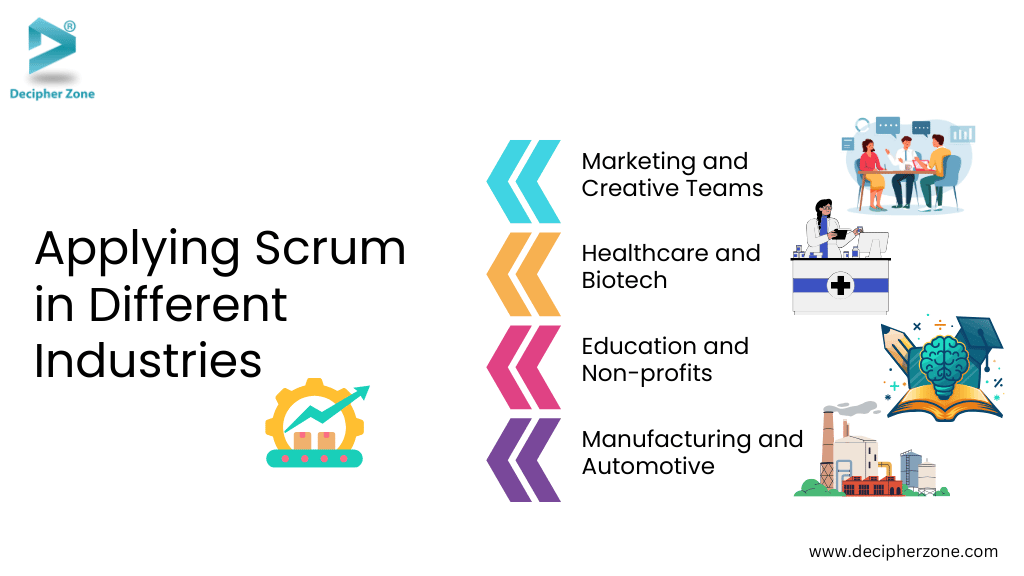
Working in sprints, marketing teams can deliver increments like completed ads or published content every cycle, then review metrics (e.g. engagement, leads) to adjust their strategy.
This approach brings more transparency and adaptability to marketing efforts, compared to long annual campaign plans. Case studies show that Scrum in marketing can shorten campaign rollout times and improve alignment between marketing and sales teams.
2. Healthcare and Biotech
In healthcare, organizations use Scrum to develop clinical software, manage process improvement projects, or even coordinate research initiatives. For example, a UK healthcare software company (Mayden) transitioned from Waterfall to Scrum to better respond to user needs.
After adopting Scrum, they were able to deliver a new product faster and with higher quality, calling it “the single most productive change we’ve made in Mayden’s ten-year history”.
The collaborative nature of Scrum helped bridge gaps between clinicians, IT, and administrators. Even in biotech R&D, teams have experimented with Scrum to incrementally plan lab work and adjust research directions based on findings every sprint.
3. Education and Non-profits
Educators have used Scrum to manage complex programs or even in classroom settings for project-based learning. For instance, teachers run class projects as mini-scrum teams, where students plan their work, have daily check-ins, and deliver a project increment (like a science fair prototype) in time-boxed iterations.
This teaches collaboration and adaptability. Non-profits managing community projects or event planning also use Scrum boards to organize tasks and ensure frequent stakeholder check-ins.
4. Manufacturing and Automotive
Agile frameworks have influenced manufacturing (though manufacturing traditionally deals with physical constraints). Scrum is sometimes used in hardware development or engineering design departments.
However, even pure hardware teams have taken cues from Scrum: breaking the project into smaller milestones, holding frequent coordination meetings, and adapting designs incrementally based on test results.
Common Challenges in Scrum Implementation
According to a Scrum Alliance survey, the most significant Scrum adoption challenges reported were:
-
Organizational Culture & Design
-
Transitioning from Waterfall
-
Undefined Success Metrics
-
Alignment with Other Teams/Projects
-
Lack of Trust in Teams
-
Low Enthusiasm or Buy-In
Implementing Scrum is not without its challenges. Many teams encounter obstacles when transitioning from traditional methods or in the course of practicing Scrum.
1. Organizational Culture & Design
51% of respondents said their company’s existing culture/structure made it difficult to adopt Agile and Scrum. Rigid hierarchies or command-and-control mindsets clash with Scrum’s collaborative, self-organizing nature. For Scrum to take root, organizations often need to shift to a more trust-based, learning-oriented culture.
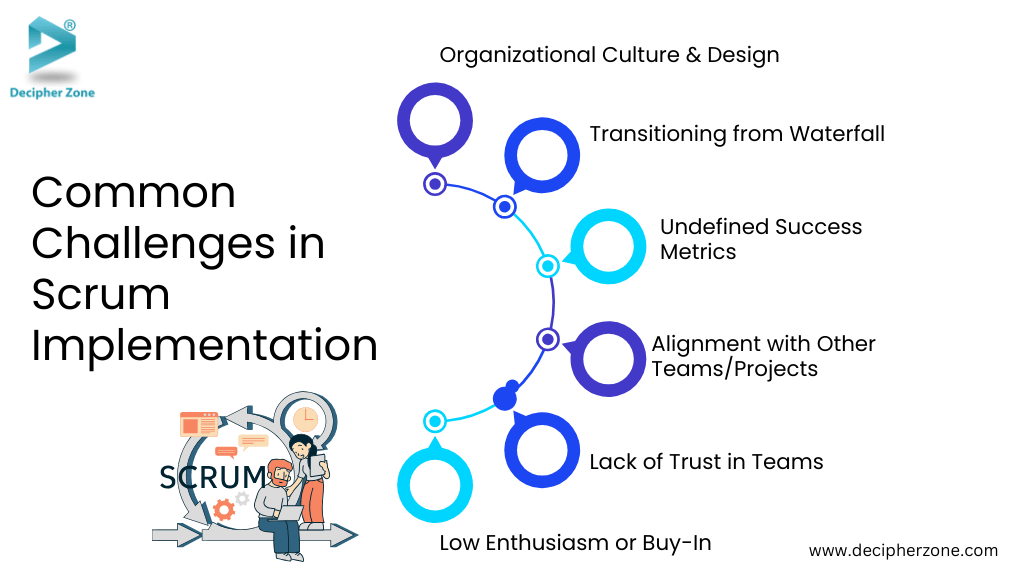
2. Transitioning from Waterfall
44% struggled with moving from a traditional Waterfall approach to Scrum. Old habits like expecting fixed scope, or teams being organized in silos (analysis, dev, test separately) can impede Scrum, which demands cross-functional teams and flexibility. The inertia of “how we’ve always done it” can be hard to overcome.
3. Undefined Success Metrics
41% noted a lack of clear metrics to identify and measure success in Scrum. Unlike Waterfall which might use milestone completion, Scrum teams and management may be unsure how to measure progress (beyond velocity) or impact. Establishing meaningful KPIs (like customer satisfaction, cycle time, defect rates) is crucial to demonstrate Scrum’s value.
4. Alignment with Other Teams/Projects
40% found it challenging to align Scrum teams with other projects in a portfolio. If the rest of the organization isn’t agile, Scrum teams can face external dependencies or conflicting timelines. Coordination mechanisms (like Scrum of Scrums or scaled agile frameworks) are needed when multiple teams must collaborate.
5. Lack of Trust in Teams
38% cited lack of trust as an issue. Management or customers may not yet trust the team’s process or estimates, possibly leading to micromanagement or pressure that disrupts Scrum. Conversely, team members need to trust each other to speak openly (e.g. in retrospectives) and to take ownership.
6. Low Enthusiasm or Buy-In
34% pointed to lack of enthusiasm from team members or Product Owners. If the team is just going through the motions without believing in Scrum, the events can become perfunctory. Or a Product Owner who isn’t fully engaged can derail the process by not providing timely input or decisions. Genuine buy-in at all levels is needed for Scrum to flourish.
Read: SDLC(Software Development Lifecycle)
Success Factors and Best Practices for Scrum Teams
There are several success factors and best practices that can dramatically improve a Scrum team’s effectiveness and outcomes:
-
Executive Support and Agile Mindset
-
Clear Roles and Training
-
Cross-Functional, Empowered Team
-
Focus on Customer Value
-
Effective Scrum Ceremonies
-
Sustainable Pace and Quality Practices
-
Transparency and Communication
-
Continuous Improvement and Learning
1. Executive Support and Agile Mindset
For Scrum teams to reach their potential, management must not only permit Agile ways of working but actively support them. This means trusting teams to self-organize, providing necessary resources (e.g. training, tools), and removing systemic impediments.
When leadership champions Agile values and gives teams psychological safety to experiment and sometimes fail, Scrum can truly thrive. An organization aligned on Agile mindset will integrate Scrum teams into its strategy rather than treating them as isolated experiments.
.avif)
2. Clear Roles and Training
Ensure that everyone understands their role and responsibilities in Scrum. A well-trained Product Owner who can write effective user stories and prioritize decisively, and a skilled Scrum Master who can facilitate and coach, make a huge difference.
Investing in certification or workshops can be worthwhile. It’s also a best practice to educate stakeholders on how Scrum works so that, for example, clients know to expect demos every sprint and provide feedback, rather than waiting until the end. Clarity on roles prevents confusion and overlap, and allows the team to work in unison.
3. Cross-Functional, Empowered Team
Scrum teams should have all the skills needed to deliver increments (dev, QA, design, etc.) and team members should collaborate rather than work in silos. Encourage teamwork by co-locating team members (or using good virtual collaboration tools for distributed teams), and by fostering respect for each person’s contributions.
Empower the team to make technical decisions and to estimate their own work – this autonomy drives accountability and creativity. Keeping the team size manageable (5-9 people) also helps maintain effective communication.
4. Focus on Customer Value
The Product Owner and team should keep the focus on delivering customer-centric value in each sprint. Techniques like defining clear acceptance criteria for user stories, and regularly re-prioritizing the backlog based on user feedback or market changes, ensure the team is always working on the most impactful things.
A best practice is to frequently remind the team of the “why” behind each backlog item (the user context) so that everyone is aligned with the end-user’s needs.
5. Effective Scrum Ceremonies
Make the Scrum events productive and engaging. For example, in Sprint Planning, make sure the team discusses each selected story enough to understand it and feels confident it can be done. In Daily Scrums, keep it time-boxed and focused on coordination (not status reporting to a manager).
For Sprint Reviews, allow key stakeholders to attend and give feedback; this makes stakeholders feel involved and gives the team valuable perspectives. And crucially, hold Retrospectives consistently and act on their outcomes. The retrospective is where the team identifies process improvements – perhaps they need a better code review practice or to change how they estimate.
Implementing improvement ideas in the next sprint shows the team that the retrospective matters, leading to continuous improvement (remember the earlier quote about retrospectives being the linchpin of Agile success).
.avif)
6. Sustainable Pace and Quality Practices
Scrum teams perform best when maintaining a sustainable work pace. Burning out the team with overtime is counterproductive; instead, velocity should stabilize over time at a pace the team can comfortably sustain. Encourage technical excellence by integrating good engineering practices: automated testing, code reviews, continuous integration, and so on.
“Definition of Done” should be clearly defined (e.g. code completed and tested, integrated, documented) to avoid quality shortcuts. When quality is baked in, the increments truly become potentially shippable, and the team doesn’t accumulate crippling technical debt.
7. Transparency and Communication
Encourage an environment where team members freely communicate issues and ideas. If something is blocking progress, the Scrum Master should find out quickly (often via the daily scrum) and seek to resolve it. Make use of information radiators (task boards, burndown charts visible to all) to radiate progress.
High transparency builds trust with stakeholders as well – they see the team’s progress and challenges in real-time. As one Scrum principle states, “Scrum’s roles, artifacts, events, and rules exist to create minimal disruption and maximum transparency” – this transparency enables empiricism, where decisions are based on observed reality.
8. Continuous Improvement and Learning
The best Scrum teams are always learning – about their product domain, about better ways to collaborate, and about improving their Agile techniques. They may do brief knowledge-sharing sessions, attend Agile community meetups, or rotate roles to build empathy (e.g. a developer pairs with the PO to learn more about stakeholder management).
Some teams use metrics from their process (like analyzing why a sprint goal wasn’t met) not to blame, but to learn and adapt. Over time, this relentless improvement mindset makes the team highly adaptable and resilient. They view challenges as things to retro on and solve, not reasons to abandon Scrum.
Conclusion
Scrum development has proven itself as a powerful approach for delivering complex projects with agility and quality. By breaking work into sprints, empowering cross-functional teams, and embracing continuous feedback, Scrum helps organizations innovate faster and respond to change more effectively than traditional methods.
The journey to Scrum maturity isn’t without hurdles – teams must foster a new mindset, align stakeholders, and learn through retrospection – but the payoff is a more resilient and productive development process.
Whether you're new to Scrum or looking to optimize your Agile process, Decipher Zone offers specialized Agile product development services tailored to your unique needs.
Talk to an Agile Expert at Decipher Zone →
Remember, at the heart of Scrum’s success are people: engaged team members, supportive leadership, and satisfied customers working together in a transparent, adaptive cycle.
Read: Trends, Methodologies, and Outsourcing Strategies for 2025
If you’re looking to improve your team’s agility or considering Scrum for your next project, keep the best practices and lessons from this guide in mind. Start with the basics (roles, events, and artifacts), be patient through the learning curve, and never skip the retrospective! With time, your team can iterate into a well-oiled Scrum machine that delivers “twice the work in half the time.”
Finally, success with Scrum often comes easier with the right expertise by your side. Decipher Zone has extensive experience in Agile product development and building dedicated Scrum teams that hit the ground running. Whether you’re initiating a new Scrum team or scaling Agile across programs, our experts can guide you through the process and tailor Scrum to your unique needs.
Ready to unleash the potential of Scrum in your organization? Embrace the Agile mindset, and don’t hesitate to reach out for guidance or support. By taking the plunge into Scrum development, you’re investing in a process of continuous improvement – one that can transform not just your project outcomes, but also the culture and capability of your team for the better.

